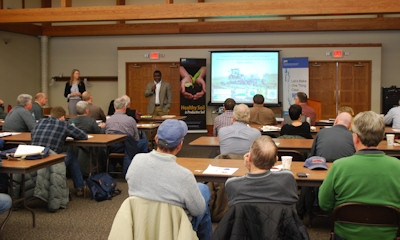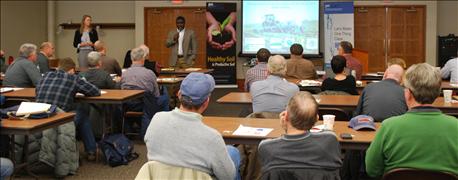
“What’s your strategy?” That was the question posed by Lyndsey Ramsey, associate director of natural and environmental resources for the Illinois Farm Bureau, at a recent community outreach meeting in Lexington. Ramsey says nutrient loss, “is an important issue and we want farmers and producers to know it really well.”
So, to gain a better understanding of the Illinois Nutrient Loss Reduction Strategy, here are five things you need to know:
1. Did you get that memo?
The Gulf Hypoxia Action Plan is a “memo”, not formal regulation.

TALKING IT OUT: Farmers and industry experts discussing the Illinois Nutrient Loss Reduction Strategy in Lexington.
According to Ramsey, “There is no new legislation or regulations, yet. This is an opportunity to prove voluntary can work.” In order to reduce the hypoxic zone, caused by lost nutrients carried downstream, the EPA developed the Gulf Hypoxia Action plan. According to Ramsey, the EPA “issued a guidance memo in 2011”. The guidance memo provides a framework for 12 states in the Mississippi River basin, “to come up with their own nutrient reduction strategies”. In addition, each state needs to determine “numeric standards”, or what level of phosphorus and nitrates is allowed, in streams and rivers. The ultimate goal is “to reduce the hypoxic zone by 45%”.
2. We have a real problem on our hands, Illinois.
According to Ramsey, an assessment conducted as part of strategy development found that Illinois contributes 20% of the nitrate load heading to the Gulf of Mexico. Depending on rainfall, Illinois and Iowa battle for the highest nutrient loss contribution.

QUESTIONS ANSWERED: Jean Payne, president of the Illinois Fertilizer and Chemical Association, answers questions from growers after her presentation at the outreach meeting.
How was that calculated? Ramsey explained that point sources, such as waste water, have permits. The permits require reporting on nitrate and phosphorus loads. And, contribution percentages from urban sources, like lawns and golf courses, are fairly accurate as well.
“So, they took 100%, subtracted what they know (point sources) and what they kind of know (urban sources), and gave agriculture what is left over,” says Ramsey.
Related: Soil sampling lays foundation for nutrient management planning
That may not seem like a fair, or accurate, way to determine agriculture’s nutrient loss contribution. However, as Ramsey points out, “We may not be 80% of the problem, but we know we have a stake in this game. We know we’re losing nutrients.”
3. Illinois Nutrient Loss Reduction Strategy: Team on three.
Key players from Illinois came together to develop the Nutrient Loss Reduction Strategy. Representatives from the Illinois EPA, land grant universities, grain and livestock associations, NRCS, and more worked together to create the Illinois Nutrient Loss Reduction Strategy. As part of the strategy, they established a checkpoint. The target for 2025 is a 15% reduction in the nitrate load and 25% reduction in the phosphorus load.
4. A tale of three states.
Illinois farmers can choose their own nutrient loss reduction strategy. That’s not the case in every state.
“There is a war going on in Iowa over water,” says Jean Payne, president of the Illinois Fertilizer and Chemical Association.
In Iowa, Des Moines Water Works filed a lawsuit against a drainage district in northwest Iowa. “The premise of the case is Water Works claims NPDES permits should be required to discharge tiles into the river,” says Payne. “Storm water is not regulated, which is why agriculture has not been subject to it.”
The lawsuit comes down to the source of water coming out of tiles. Is it ground water, or is it storm water? If the court determines that tile discharge is not exempt from the clean water act, permits may be required. A NPDES permit can regulate clarity, nitrates and ammonia. And, it will require proof of staying within the guidelines and penalties for not complying.
Ohio Farmers have a different challenge on their hands. “Lake Erie has a problem,” says Payne. She explained how for the last ten years, phosphorus sedimentation caused significant algae bloom issues. “Lake Erie turned green. No one could swim or drink the water.” In response, regulations on broadcasting phosphorus were put in place. A conservative legislative body “passed this law in a matter of a month or two,” says Payne.
The regulations make soil testing mandatory and application rates have to be within land grant university recommendations. Farmers must have documentation and approval to go above the recommended rate. The regulations even dictate when applications can be made. The law limits applications if rain is in the forecast.
“These are the kinds of things that can happen when you get behind on a topic going into legislation. We don’t want to get behind,” says Payne.
5. Embrace BMPs while the choice is still yours.
Flipping through the 130-page Nutrient Loss Reduction Strategy is a little intimidating. However, the strategy provides Best Management Practices (BMPs) for farmers to consider in order to reduce nutrient losses. The BMPs are broken down by practices, such as using MRTN rate and nitrification inhibitors, splitting nitrogen applications, planting cover crops, etc. And, it breaks down nitrate or phosphorus reductions by acre and the costs associated with the proven practice.
What farmers need to keep in mind is that this strategy is a guide to BMP options. And the recommended BMP combinations demonstrate nutrient loss reduction possibilities, not mandates. “It doesn’t have to be this combination of practices, this is just what research shows can be done,” says Ramsey. “The point is to start thinking about our state as a whole, how can we make practices work in different parts of the state to make the goal,” says Ramsey.
About the Author(s)
You May Also Like




